Business Law: Formation, Management, and Dispute Resolution Report
VerifiedAdded on 2023/01/12
|11
|3607
|47
Report
AI Summary
This report provides a detailed overview of various business organizations, including sole proprietorships, partnerships, and non-profit organizations. It defines each type, outlining their formation processes, management structures, and funding mechanisms. The report further explores the advantages and disadvantages of each organizational form, offering insights into their operational characteristics. A significant portion of the report is dedicated to evaluating dispute resolution systems within the context of employment and contract law, providing a comprehensive understanding of legal frameworks relevant to business operations. The report covers the roles of management and the sources of funding for each type of organization. Overall, the report serves as a comprehensive guide to understanding business law and the different types of business organizations.

BUSINESS LAW
Paraphrase This Document
Need a fresh take? Get an instant paraphrase of this document with our AI Paraphraser

MAIN BODY...................................................................................................................................3
Define various types of business organizations and there formation........................................3
Management, funding of different organizations with advantage and disadvantages.................5
Evaluation of dispute resolution system in relation to employment and contract law................8
CONCLUSION................................................................................................................................8
REFRENCES.................................................................................................................................10
Define various types of business organizations and there formation........................................3
Management, funding of different organizations with advantage and disadvantages.................5
Evaluation of dispute resolution system in relation to employment and contract law................8
CONCLUSION................................................................................................................................8
REFRENCES.................................................................................................................................10
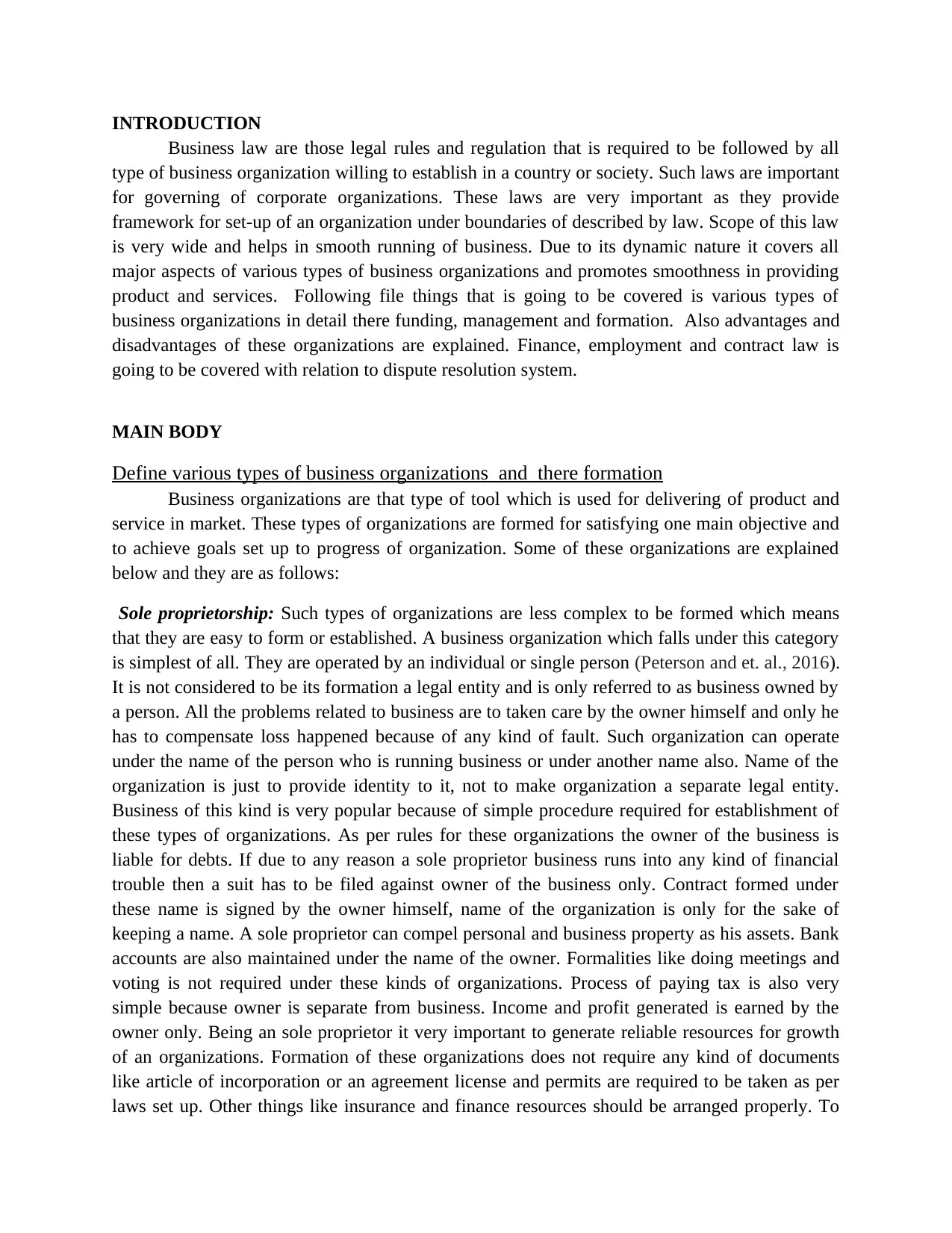
INTRODUCTION
Business law are those legal rules and regulation that is required to be followed by all
type of business organization willing to establish in a country or society. Such laws are important
for governing of corporate organizations. These laws are very important as they provide
framework for set-up of an organization under boundaries of described by law. Scope of this law
is very wide and helps in smooth running of business. Due to its dynamic nature it covers all
major aspects of various types of business organizations and promotes smoothness in providing
product and services. Following file things that is going to be covered is various types of
business organizations in detail there funding, management and formation. Also advantages and
disadvantages of these organizations are explained. Finance, employment and contract law is
going to be covered with relation to dispute resolution system.
MAIN BODY
Define various types of business organizations and there formation
Business organizations are that type of tool which is used for delivering of product and
service in market. These types of organizations are formed for satisfying one main objective and
to achieve goals set up to progress of organization. Some of these organizations are explained
below and they are as follows:
Sole proprietorship: Such types of organizations are less complex to be formed which means
that they are easy to form or established. A business organization which falls under this category
is simplest of all. They are operated by an individual or single person (Peterson and et. al., 2016).
It is not considered to be its formation a legal entity and is only referred to as business owned by
a person. All the problems related to business are to taken care by the owner himself and only he
has to compensate loss happened because of any kind of fault. Such organization can operate
under the name of the person who is running business or under another name also. Name of the
organization is just to provide identity to it, not to make organization a separate legal entity.
Business of this kind is very popular because of simple procedure required for establishment of
these types of organizations. As per rules for these organizations the owner of the business is
liable for debts. If due to any reason a sole proprietor business runs into any kind of financial
trouble then a suit has to be filed against owner of the business only. Contract formed under
these name is signed by the owner himself, name of the organization is only for the sake of
keeping a name. A sole proprietor can compel personal and business property as his assets. Bank
accounts are also maintained under the name of the owner. Formalities like doing meetings and
voting is not required under these kinds of organizations. Process of paying tax is also very
simple because owner is separate from business. Income and profit generated is earned by the
owner only. Being an sole proprietor it very important to generate reliable resources for growth
of an organizations. Formation of these organizations does not require any kind of documents
like article of incorporation or an agreement license and permits are required to be taken as per
laws set up. Other things like insurance and finance resources should be arranged properly. To
Business law are those legal rules and regulation that is required to be followed by all
type of business organization willing to establish in a country or society. Such laws are important
for governing of corporate organizations. These laws are very important as they provide
framework for set-up of an organization under boundaries of described by law. Scope of this law
is very wide and helps in smooth running of business. Due to its dynamic nature it covers all
major aspects of various types of business organizations and promotes smoothness in providing
product and services. Following file things that is going to be covered is various types of
business organizations in detail there funding, management and formation. Also advantages and
disadvantages of these organizations are explained. Finance, employment and contract law is
going to be covered with relation to dispute resolution system.
MAIN BODY
Define various types of business organizations and there formation
Business organizations are that type of tool which is used for delivering of product and
service in market. These types of organizations are formed for satisfying one main objective and
to achieve goals set up to progress of organization. Some of these organizations are explained
below and they are as follows:
Sole proprietorship: Such types of organizations are less complex to be formed which means
that they are easy to form or established. A business organization which falls under this category
is simplest of all. They are operated by an individual or single person (Peterson and et. al., 2016).
It is not considered to be its formation a legal entity and is only referred to as business owned by
a person. All the problems related to business are to taken care by the owner himself and only he
has to compensate loss happened because of any kind of fault. Such organization can operate
under the name of the person who is running business or under another name also. Name of the
organization is just to provide identity to it, not to make organization a separate legal entity.
Business of this kind is very popular because of simple procedure required for establishment of
these types of organizations. As per rules for these organizations the owner of the business is
liable for debts. If due to any reason a sole proprietor business runs into any kind of financial
trouble then a suit has to be filed against owner of the business only. Contract formed under
these name is signed by the owner himself, name of the organization is only for the sake of
keeping a name. A sole proprietor can compel personal and business property as his assets. Bank
accounts are also maintained under the name of the owner. Formalities like doing meetings and
voting is not required under these kinds of organizations. Process of paying tax is also very
simple because owner is separate from business. Income and profit generated is earned by the
owner only. Being an sole proprietor it very important to generate reliable resources for growth
of an organizations. Formation of these organizations does not require any kind of documents
like article of incorporation or an agreement license and permits are required to be taken as per
laws set up. Other things like insurance and finance resources should be arranged properly. To
⊘ This is a preview!⊘
Do you want full access?
Subscribe today to unlock all pages.

Trusted by 1+ million students worldwide
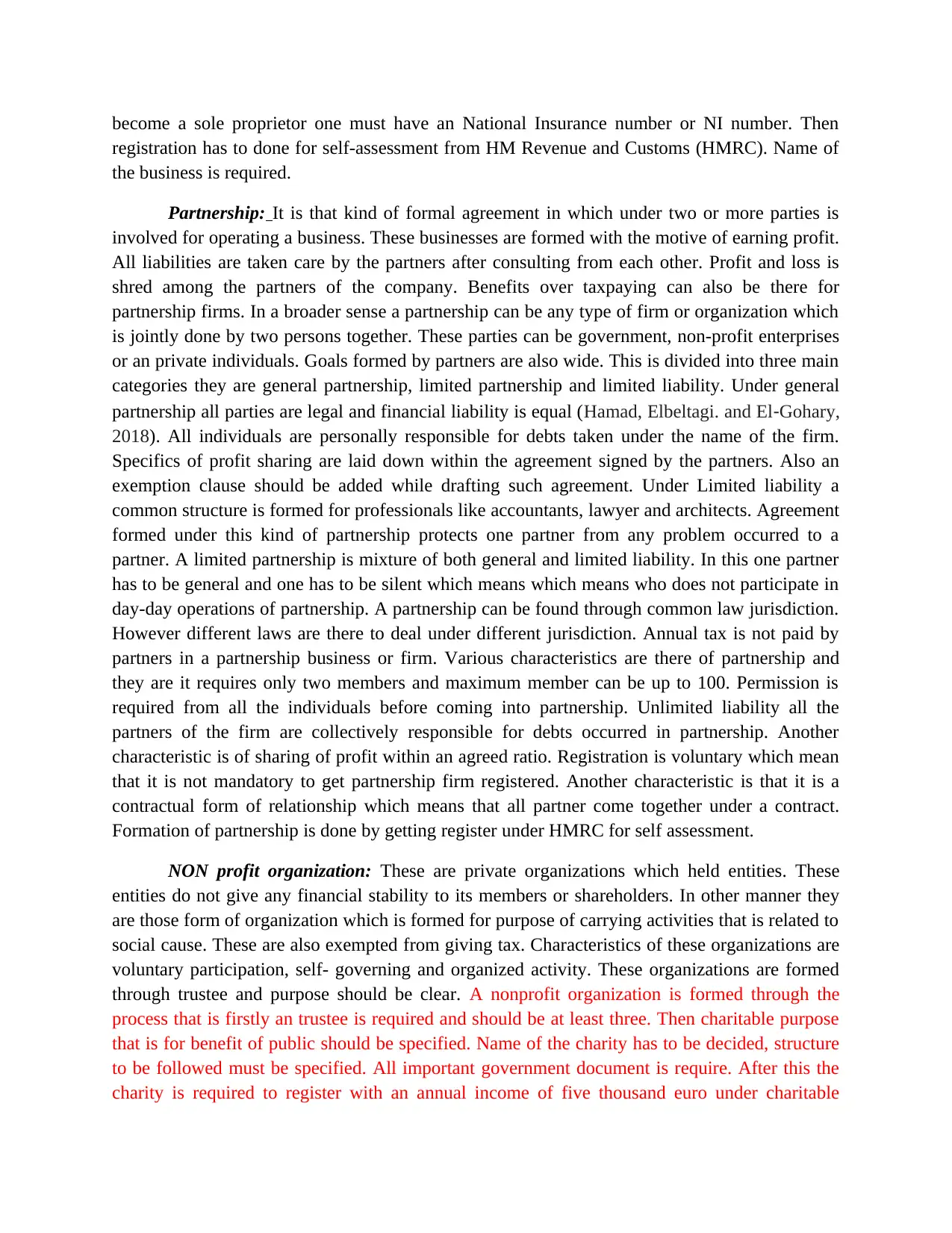
become a sole proprietor one must have an National Insurance number or NI number. Then
registration has to done for self-assessment from HM Revenue and Customs (HMRC). Name of
the business is required.
Partnership: It is that kind of formal agreement in which under two or more parties is
involved for operating a business. These businesses are formed with the motive of earning profit.
All liabilities are taken care by the partners after consulting from each other. Profit and loss is
shred among the partners of the company. Benefits over taxpaying can also be there for
partnership firms. In a broader sense a partnership can be any type of firm or organization which
is jointly done by two persons together. These parties can be government, non-profit enterprises
or an private individuals. Goals formed by partners are also wide. This is divided into three main
categories they are general partnership, limited partnership and limited liability. Under general
partnership all parties are legal and financial liability is equal (Hamad, Elbeltagi. and El‐Gohary,
2018). All individuals are personally responsible for debts taken under the name of the firm.
Specifics of profit sharing are laid down within the agreement signed by the partners. Also an
exemption clause should be added while drafting such agreement. Under Limited liability a
common structure is formed for professionals like accountants, lawyer and architects. Agreement
formed under this kind of partnership protects one partner from any problem occurred to a
partner. A limited partnership is mixture of both general and limited liability. In this one partner
has to be general and one has to be silent which means which means who does not participate in
day-day operations of partnership. A partnership can be found through common law jurisdiction.
However different laws are there to deal under different jurisdiction. Annual tax is not paid by
partners in a partnership business or firm. Various characteristics are there of partnership and
they are it requires only two members and maximum member can be up to 100. Permission is
required from all the individuals before coming into partnership. Unlimited liability all the
partners of the firm are collectively responsible for debts occurred in partnership. Another
characteristic is of sharing of profit within an agreed ratio. Registration is voluntary which mean
that it is not mandatory to get partnership firm registered. Another characteristic is that it is a
contractual form of relationship which means that all partner come together under a contract.
Formation of partnership is done by getting register under HMRC for self assessment.
NON profit organization: These are private organizations which held entities. These
entities do not give any financial stability to its members or shareholders. In other manner they
are those form of organization which is formed for purpose of carrying activities that is related to
social cause. These are also exempted from giving tax. Characteristics of these organizations are
voluntary participation, self- governing and organized activity. These organizations are formed
through trustee and purpose should be clear. A nonprofit organization is formed through the
process that is firstly an trustee is required and should be at least three. Then charitable purpose
that is for benefit of public should be specified. Name of the charity has to be decided, structure
to be followed must be specified. All important government document is require. After this the
charity is required to register with an annual income of five thousand euro under charitable
registration has to done for self-assessment from HM Revenue and Customs (HMRC). Name of
the business is required.
Partnership: It is that kind of formal agreement in which under two or more parties is
involved for operating a business. These businesses are formed with the motive of earning profit.
All liabilities are taken care by the partners after consulting from each other. Profit and loss is
shred among the partners of the company. Benefits over taxpaying can also be there for
partnership firms. In a broader sense a partnership can be any type of firm or organization which
is jointly done by two persons together. These parties can be government, non-profit enterprises
or an private individuals. Goals formed by partners are also wide. This is divided into three main
categories they are general partnership, limited partnership and limited liability. Under general
partnership all parties are legal and financial liability is equal (Hamad, Elbeltagi. and El‐Gohary,
2018). All individuals are personally responsible for debts taken under the name of the firm.
Specifics of profit sharing are laid down within the agreement signed by the partners. Also an
exemption clause should be added while drafting such agreement. Under Limited liability a
common structure is formed for professionals like accountants, lawyer and architects. Agreement
formed under this kind of partnership protects one partner from any problem occurred to a
partner. A limited partnership is mixture of both general and limited liability. In this one partner
has to be general and one has to be silent which means which means who does not participate in
day-day operations of partnership. A partnership can be found through common law jurisdiction.
However different laws are there to deal under different jurisdiction. Annual tax is not paid by
partners in a partnership business or firm. Various characteristics are there of partnership and
they are it requires only two members and maximum member can be up to 100. Permission is
required from all the individuals before coming into partnership. Unlimited liability all the
partners of the firm are collectively responsible for debts occurred in partnership. Another
characteristic is of sharing of profit within an agreed ratio. Registration is voluntary which mean
that it is not mandatory to get partnership firm registered. Another characteristic is that it is a
contractual form of relationship which means that all partner come together under a contract.
Formation of partnership is done by getting register under HMRC for self assessment.
NON profit organization: These are private organizations which held entities. These
entities do not give any financial stability to its members or shareholders. In other manner they
are those form of organization which is formed for purpose of carrying activities that is related to
social cause. These are also exempted from giving tax. Characteristics of these organizations are
voluntary participation, self- governing and organized activity. These organizations are formed
through trustee and purpose should be clear. A nonprofit organization is formed through the
process that is firstly an trustee is required and should be at least three. Then charitable purpose
that is for benefit of public should be specified. Name of the charity has to be decided, structure
to be followed must be specified. All important government document is require. After this the
charity is required to register with an annual income of five thousand euro under charitable
Paraphrase This Document
Need a fresh take? Get an instant paraphrase of this document with our AI Paraphraser
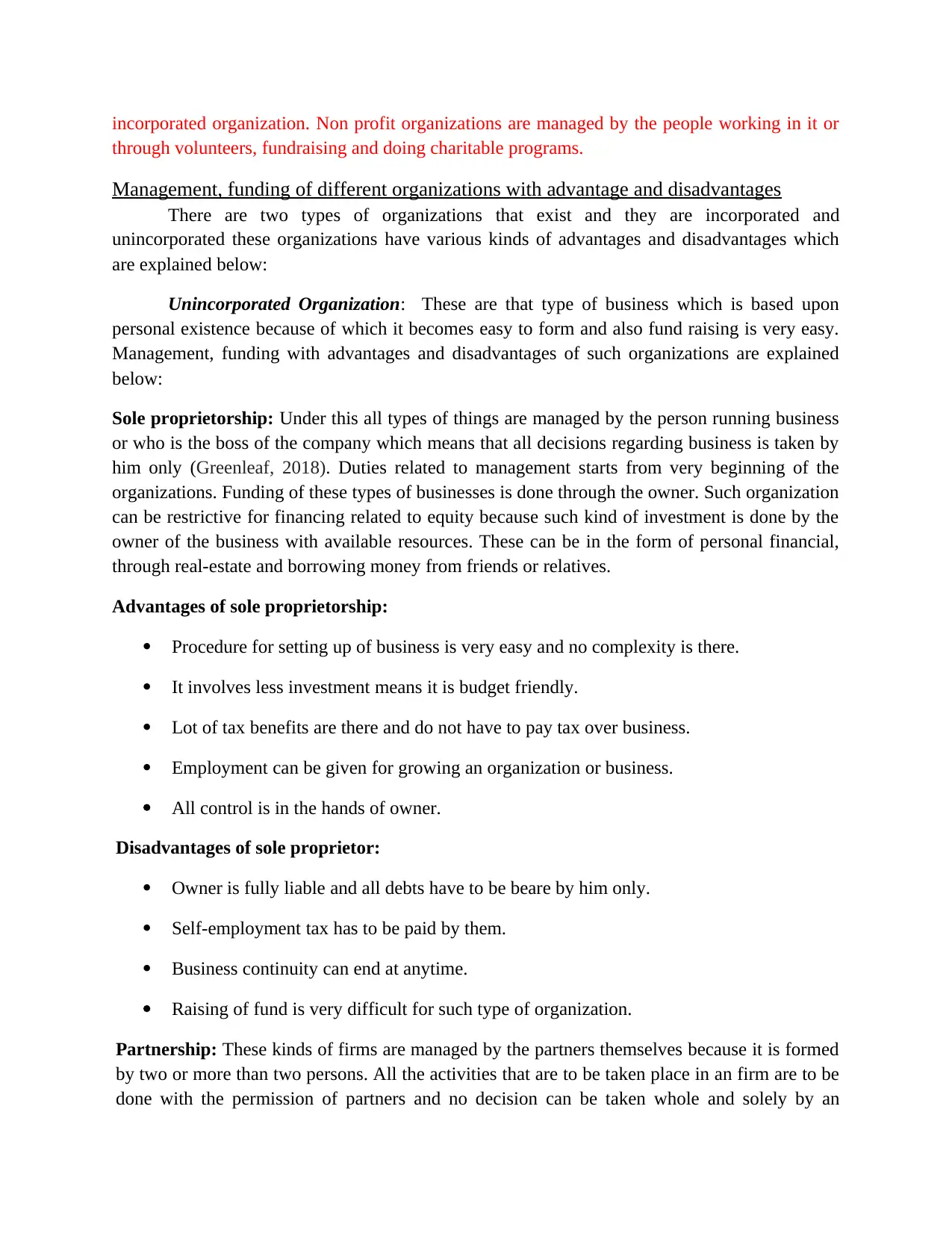
incorporated organization. Non profit organizations are managed by the people working in it or
through volunteers, fundraising and doing charitable programs.
Management, funding of different organizations with advantage and disadvantages
There are two types of organizations that exist and they are incorporated and
unincorporated these organizations have various kinds of advantages and disadvantages which
are explained below:
Unincorporated Organization: These are that type of business which is based upon
personal existence because of which it becomes easy to form and also fund raising is very easy.
Management, funding with advantages and disadvantages of such organizations are explained
below:
Sole proprietorship: Under this all types of things are managed by the person running business
or who is the boss of the company which means that all decisions regarding business is taken by
him only (Greenleaf, 2018). Duties related to management starts from very beginning of the
organizations. Funding of these types of businesses is done through the owner. Such organization
can be restrictive for financing related to equity because such kind of investment is done by the
owner of the business with available resources. These can be in the form of personal financial,
through real-estate and borrowing money from friends or relatives.
Advantages of sole proprietorship:
Procedure for setting up of business is very easy and no complexity is there.
It involves less investment means it is budget friendly.
Lot of tax benefits are there and do not have to pay tax over business.
Employment can be given for growing an organization or business.
All control is in the hands of owner.
Disadvantages of sole proprietor:
Owner is fully liable and all debts have to be beare by him only.
Self-employment tax has to be paid by them.
Business continuity can end at anytime.
Raising of fund is very difficult for such type of organization.
Partnership: These kinds of firms are managed by the partners themselves because it is formed
by two or more than two persons. All the activities that are to be taken place in an firm are to be
done with the permission of partners and no decision can be taken whole and solely by an
through volunteers, fundraising and doing charitable programs.
Management, funding of different organizations with advantage and disadvantages
There are two types of organizations that exist and they are incorporated and
unincorporated these organizations have various kinds of advantages and disadvantages which
are explained below:
Unincorporated Organization: These are that type of business which is based upon
personal existence because of which it becomes easy to form and also fund raising is very easy.
Management, funding with advantages and disadvantages of such organizations are explained
below:
Sole proprietorship: Under this all types of things are managed by the person running business
or who is the boss of the company which means that all decisions regarding business is taken by
him only (Greenleaf, 2018). Duties related to management starts from very beginning of the
organizations. Funding of these types of businesses is done through the owner. Such organization
can be restrictive for financing related to equity because such kind of investment is done by the
owner of the business with available resources. These can be in the form of personal financial,
through real-estate and borrowing money from friends or relatives.
Advantages of sole proprietorship:
Procedure for setting up of business is very easy and no complexity is there.
It involves less investment means it is budget friendly.
Lot of tax benefits are there and do not have to pay tax over business.
Employment can be given for growing an organization or business.
All control is in the hands of owner.
Disadvantages of sole proprietor:
Owner is fully liable and all debts have to be beare by him only.
Self-employment tax has to be paid by them.
Business continuity can end at anytime.
Raising of fund is very difficult for such type of organization.
Partnership: These kinds of firms are managed by the partners themselves because it is formed
by two or more than two persons. All the activities that are to be taken place in an firm are to be
done with the permission of partners and no decision can be taken whole and solely by an
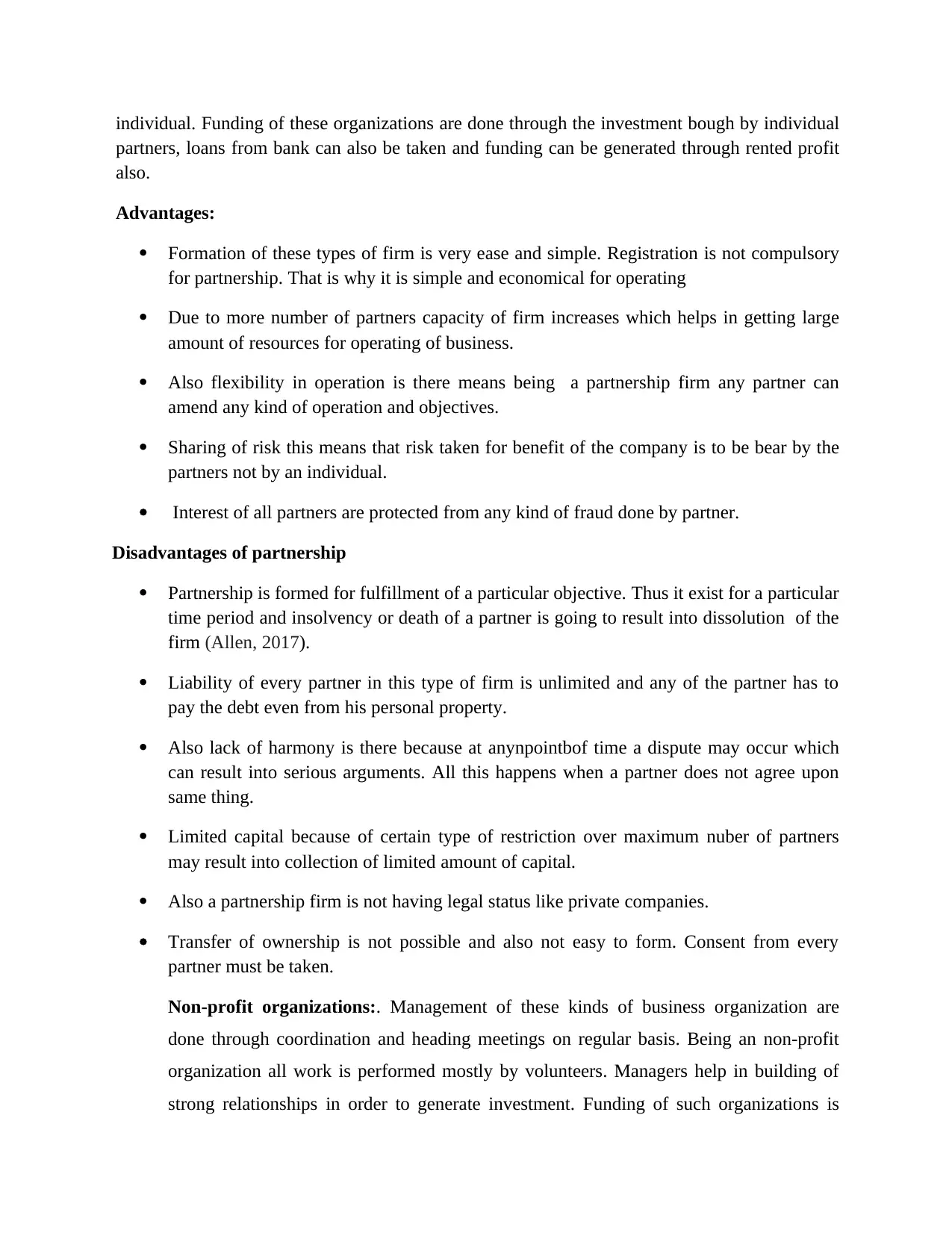
individual. Funding of these organizations are done through the investment bough by individual
partners, loans from bank can also be taken and funding can be generated through rented profit
also.
Advantages:
Formation of these types of firm is very ease and simple. Registration is not compulsory
for partnership. That is why it is simple and economical for operating
Due to more number of partners capacity of firm increases which helps in getting large
amount of resources for operating of business.
Also flexibility in operation is there means being a partnership firm any partner can
amend any kind of operation and objectives.
Sharing of risk this means that risk taken for benefit of the company is to be bear by the
partners not by an individual.
Interest of all partners are protected from any kind of fraud done by partner.
Disadvantages of partnership
Partnership is formed for fulfillment of a particular objective. Thus it exist for a particular
time period and insolvency or death of a partner is going to result into dissolution of the
firm (Allen, 2017).
Liability of every partner in this type of firm is unlimited and any of the partner has to
pay the debt even from his personal property.
Also lack of harmony is there because at anynpointbof time a dispute may occur which
can result into serious arguments. All this happens when a partner does not agree upon
same thing.
Limited capital because of certain type of restriction over maximum nuber of partners
may result into collection of limited amount of capital.
Also a partnership firm is not having legal status like private companies.
Transfer of ownership is not possible and also not easy to form. Consent from every
partner must be taken.
Non-profit organizations:. Management of these kinds of business organization are
done through coordination and heading meetings on regular basis. Being an non-profit
organization all work is performed mostly by volunteers. Managers help in building of
strong relationships in order to generate investment. Funding of such organizations is
partners, loans from bank can also be taken and funding can be generated through rented profit
also.
Advantages:
Formation of these types of firm is very ease and simple. Registration is not compulsory
for partnership. That is why it is simple and economical for operating
Due to more number of partners capacity of firm increases which helps in getting large
amount of resources for operating of business.
Also flexibility in operation is there means being a partnership firm any partner can
amend any kind of operation and objectives.
Sharing of risk this means that risk taken for benefit of the company is to be bear by the
partners not by an individual.
Interest of all partners are protected from any kind of fraud done by partner.
Disadvantages of partnership
Partnership is formed for fulfillment of a particular objective. Thus it exist for a particular
time period and insolvency or death of a partner is going to result into dissolution of the
firm (Allen, 2017).
Liability of every partner in this type of firm is unlimited and any of the partner has to
pay the debt even from his personal property.
Also lack of harmony is there because at anynpointbof time a dispute may occur which
can result into serious arguments. All this happens when a partner does not agree upon
same thing.
Limited capital because of certain type of restriction over maximum nuber of partners
may result into collection of limited amount of capital.
Also a partnership firm is not having legal status like private companies.
Transfer of ownership is not possible and also not easy to form. Consent from every
partner must be taken.
Non-profit organizations:. Management of these kinds of business organization are
done through coordination and heading meetings on regular basis. Being an non-profit
organization all work is performed mostly by volunteers. Managers help in building of
strong relationships in order to generate investment. Funding of such organizations is
⊘ This is a preview!⊘
Do you want full access?
Subscribe today to unlock all pages.

Trusted by 1+ million students worldwide
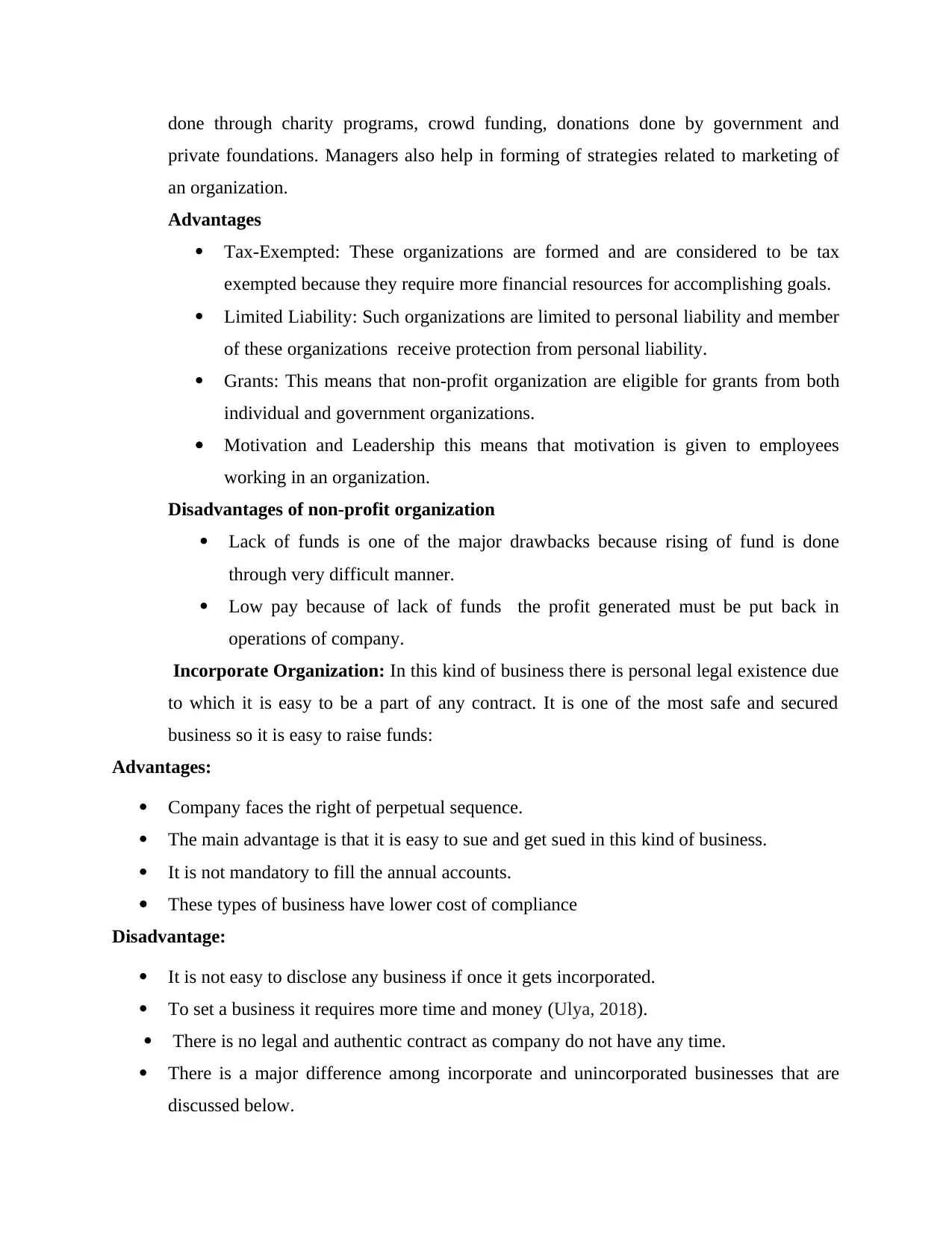
done through charity programs, crowd funding, donations done by government and
private foundations. Managers also help in forming of strategies related to marketing of
an organization.
Advantages
Tax-Exempted: These organizations are formed and are considered to be tax
exempted because they require more financial resources for accomplishing goals.
Limited Liability: Such organizations are limited to personal liability and member
of these organizations receive protection from personal liability.
Grants: This means that non-profit organization are eligible for grants from both
individual and government organizations.
Motivation and Leadership this means that motivation is given to employees
working in an organization.
Disadvantages of non-profit organization
Lack of funds is one of the major drawbacks because rising of fund is done
through very difficult manner.
Low pay because of lack of funds the profit generated must be put back in
operations of company.
Incorporate Organization: In this kind of business there is personal legal existence due
to which it is easy to be a part of any contract. It is one of the most safe and secured
business so it is easy to raise funds:
Advantages:
Company faces the right of perpetual sequence.
The main advantage is that it is easy to sue and get sued in this kind of business.
It is not mandatory to fill the annual accounts.
These types of business have lower cost of compliance
Disadvantage:
It is not easy to disclose any business if once it gets incorporated.
To set a business it requires more time and money (Ulya, 2018).
There is no legal and authentic contract as company do not have any time.
There is a major difference among incorporate and unincorporated businesses that are
discussed below.
private foundations. Managers also help in forming of strategies related to marketing of
an organization.
Advantages
Tax-Exempted: These organizations are formed and are considered to be tax
exempted because they require more financial resources for accomplishing goals.
Limited Liability: Such organizations are limited to personal liability and member
of these organizations receive protection from personal liability.
Grants: This means that non-profit organization are eligible for grants from both
individual and government organizations.
Motivation and Leadership this means that motivation is given to employees
working in an organization.
Disadvantages of non-profit organization
Lack of funds is one of the major drawbacks because rising of fund is done
through very difficult manner.
Low pay because of lack of funds the profit generated must be put back in
operations of company.
Incorporate Organization: In this kind of business there is personal legal existence due
to which it is easy to be a part of any contract. It is one of the most safe and secured
business so it is easy to raise funds:
Advantages:
Company faces the right of perpetual sequence.
The main advantage is that it is easy to sue and get sued in this kind of business.
It is not mandatory to fill the annual accounts.
These types of business have lower cost of compliance
Disadvantage:
It is not easy to disclose any business if once it gets incorporated.
To set a business it requires more time and money (Ulya, 2018).
There is no legal and authentic contract as company do not have any time.
There is a major difference among incorporate and unincorporated businesses that are
discussed below.
Paraphrase This Document
Need a fresh take? Get an instant paraphrase of this document with our AI Paraphraser
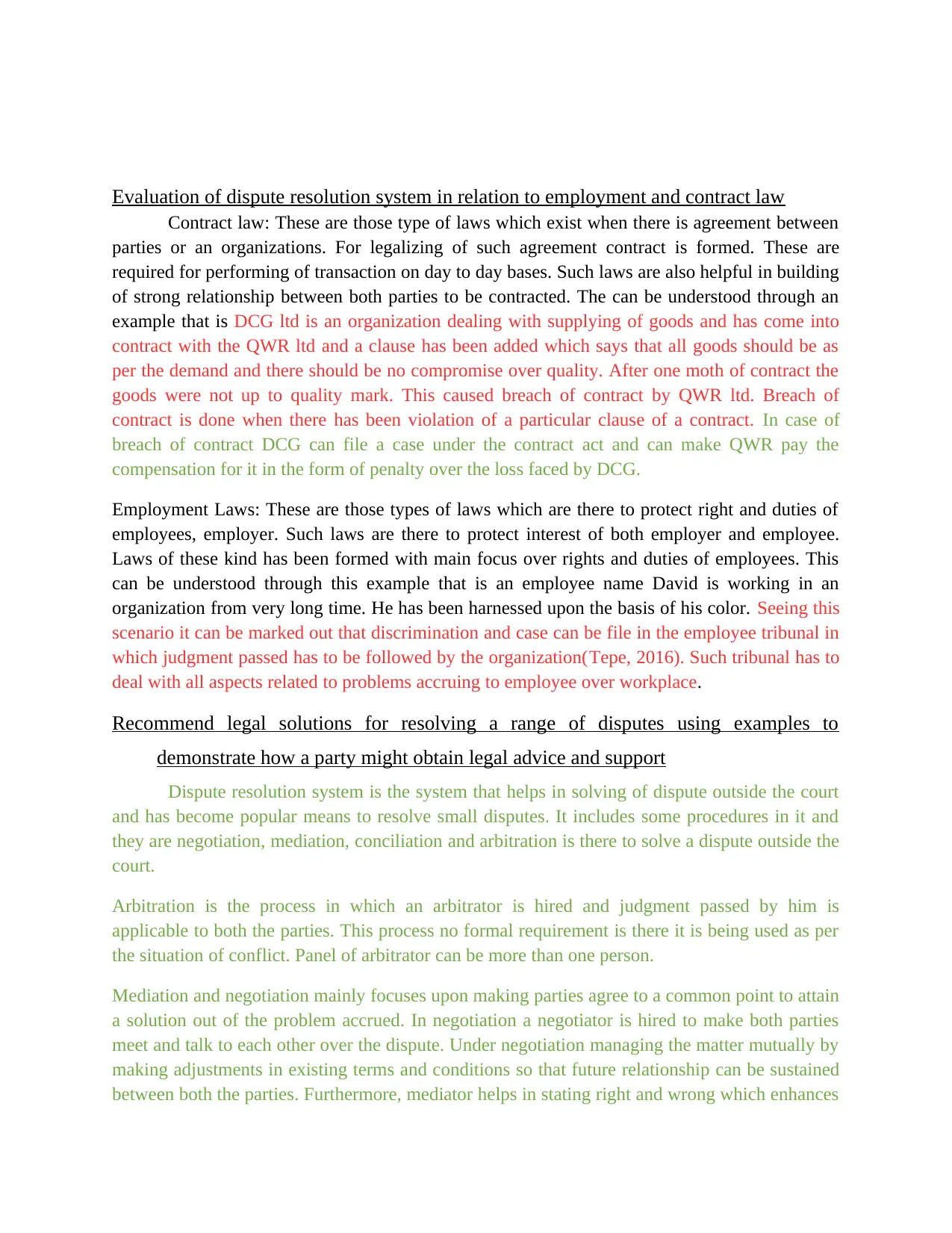
Evaluation of dispute resolution system in relation to employment and contract law
Contract law: These are those type of laws which exist when there is agreement between
parties or an organizations. For legalizing of such agreement contract is formed. These are
required for performing of transaction on day to day bases. Such laws are also helpful in building
of strong relationship between both parties to be contracted. The can be understood through an
example that is DCG ltd is an organization dealing with supplying of goods and has come into
contract with the QWR ltd and a clause has been added which says that all goods should be as
per the demand and there should be no compromise over quality. After one moth of contract the
goods were not up to quality mark. This caused breach of contract by QWR ltd. Breach of
contract is done when there has been violation of a particular clause of a contract. In case of
breach of contract DCG can file a case under the contract act and can make QWR pay the
compensation for it in the form of penalty over the loss faced by DCG.
Employment Laws: These are those types of laws which are there to protect right and duties of
employees, employer. Such laws are there to protect interest of both employer and employee.
Laws of these kind has been formed with main focus over rights and duties of employees. This
can be understood through this example that is an employee name David is working in an
organization from very long time. He has been harnessed upon the basis of his color. Seeing this
scenario it can be marked out that discrimination and case can be file in the employee tribunal in
which judgment passed has to be followed by the organization(Tepe, 2016). Such tribunal has to
deal with all aspects related to problems accruing to employee over workplace.
Recommend legal solutions for resolving a range of disputes using examples to
demonstrate how a party might obtain legal advice and support
Dispute resolution system is the system that helps in solving of dispute outside the court
and has become popular means to resolve small disputes. It includes some procedures in it and
they are negotiation, mediation, conciliation and arbitration is there to solve a dispute outside the
court.
Arbitration is the process in which an arbitrator is hired and judgment passed by him is
applicable to both the parties. This process no formal requirement is there it is being used as per
the situation of conflict. Panel of arbitrator can be more than one person.
Mediation and negotiation mainly focuses upon making parties agree to a common point to attain
a solution out of the problem accrued. In negotiation a negotiator is hired to make both parties
meet and talk to each other over the dispute. Under negotiation managing the matter mutually by
making adjustments in existing terms and conditions so that future relationship can be sustained
between both the parties. Furthermore, mediator helps in stating right and wrong which enhances
Contract law: These are those type of laws which exist when there is agreement between
parties or an organizations. For legalizing of such agreement contract is formed. These are
required for performing of transaction on day to day bases. Such laws are also helpful in building
of strong relationship between both parties to be contracted. The can be understood through an
example that is DCG ltd is an organization dealing with supplying of goods and has come into
contract with the QWR ltd and a clause has been added which says that all goods should be as
per the demand and there should be no compromise over quality. After one moth of contract the
goods were not up to quality mark. This caused breach of contract by QWR ltd. Breach of
contract is done when there has been violation of a particular clause of a contract. In case of
breach of contract DCG can file a case under the contract act and can make QWR pay the
compensation for it in the form of penalty over the loss faced by DCG.
Employment Laws: These are those types of laws which are there to protect right and duties of
employees, employer. Such laws are there to protect interest of both employer and employee.
Laws of these kind has been formed with main focus over rights and duties of employees. This
can be understood through this example that is an employee name David is working in an
organization from very long time. He has been harnessed upon the basis of his color. Seeing this
scenario it can be marked out that discrimination and case can be file in the employee tribunal in
which judgment passed has to be followed by the organization(Tepe, 2016). Such tribunal has to
deal with all aspects related to problems accruing to employee over workplace.
Recommend legal solutions for resolving a range of disputes using examples to
demonstrate how a party might obtain legal advice and support
Dispute resolution system is the system that helps in solving of dispute outside the court
and has become popular means to resolve small disputes. It includes some procedures in it and
they are negotiation, mediation, conciliation and arbitration is there to solve a dispute outside the
court.
Arbitration is the process in which an arbitrator is hired and judgment passed by him is
applicable to both the parties. This process no formal requirement is there it is being used as per
the situation of conflict. Panel of arbitrator can be more than one person.
Mediation and negotiation mainly focuses upon making parties agree to a common point to attain
a solution out of the problem accrued. In negotiation a negotiator is hired to make both parties
meet and talk to each other over the dispute. Under negotiation managing the matter mutually by
making adjustments in existing terms and conditions so that future relationship can be sustained
between both the parties. Furthermore, mediator helps in stating right and wrong which enhances
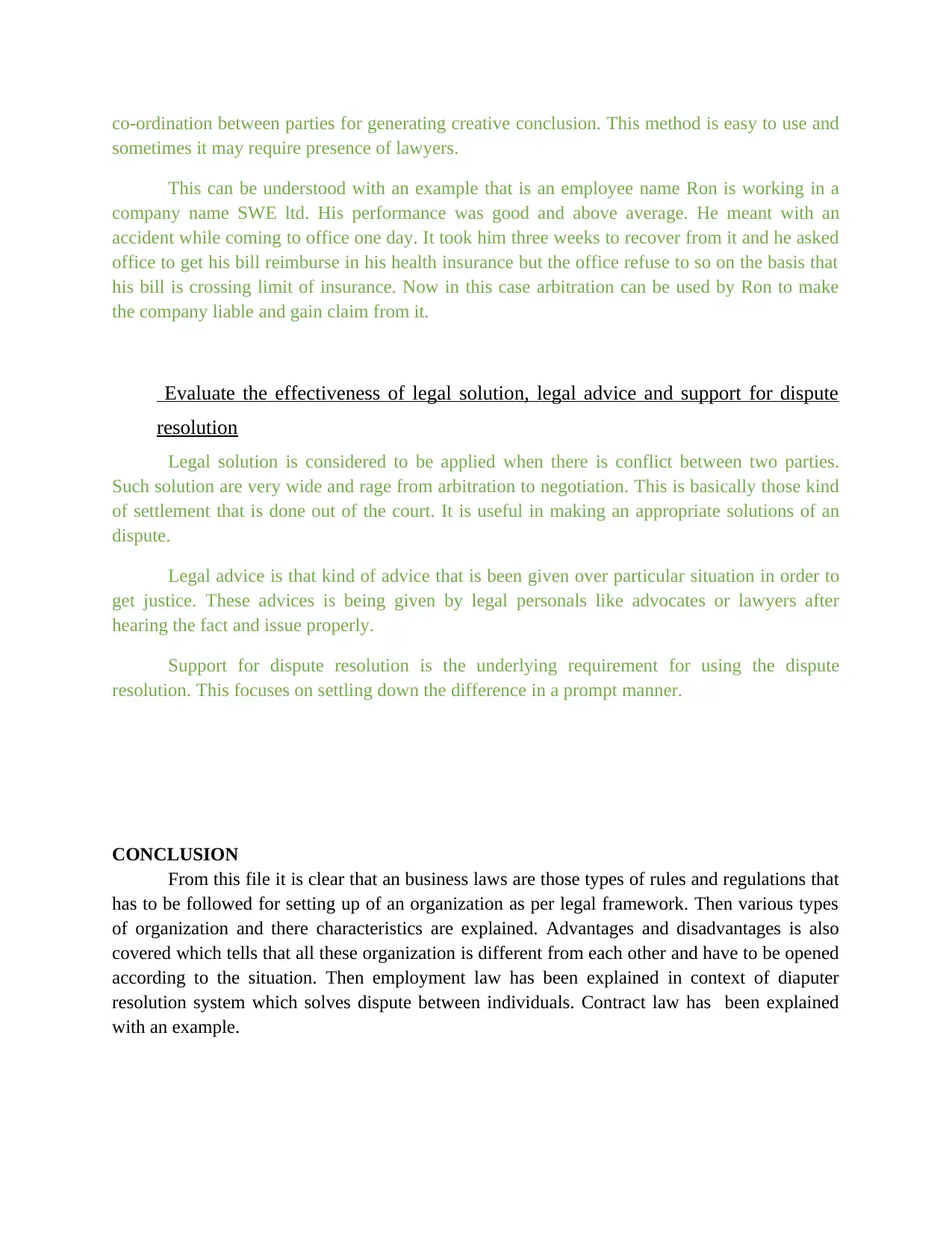
co-ordination between parties for generating creative conclusion. This method is easy to use and
sometimes it may require presence of lawyers.
This can be understood with an example that is an employee name Ron is working in a
company name SWE ltd. His performance was good and above average. He meant with an
accident while coming to office one day. It took him three weeks to recover from it and he asked
office to get his bill reimburse in his health insurance but the office refuse to so on the basis that
his bill is crossing limit of insurance. Now in this case arbitration can be used by Ron to make
the company liable and gain claim from it.
Evaluate the effectiveness of legal solution, legal advice and support for dispute
resolution
Legal solution is considered to be applied when there is conflict between two parties.
Such solution are very wide and rage from arbitration to negotiation. This is basically those kind
of settlement that is done out of the court. It is useful in making an appropriate solutions of an
dispute.
Legal advice is that kind of advice that is been given over particular situation in order to
get justice. These advices is being given by legal personals like advocates or lawyers after
hearing the fact and issue properly.
Support for dispute resolution is the underlying requirement for using the dispute
resolution. This focuses on settling down the difference in a prompt manner.
CONCLUSION
From this file it is clear that an business laws are those types of rules and regulations that
has to be followed for setting up of an organization as per legal framework. Then various types
of organization and there characteristics are explained. Advantages and disadvantages is also
covered which tells that all these organization is different from each other and have to be opened
according to the situation. Then employment law has been explained in context of diaputer
resolution system which solves dispute between individuals. Contract law has been explained
with an example.
sometimes it may require presence of lawyers.
This can be understood with an example that is an employee name Ron is working in a
company name SWE ltd. His performance was good and above average. He meant with an
accident while coming to office one day. It took him three weeks to recover from it and he asked
office to get his bill reimburse in his health insurance but the office refuse to so on the basis that
his bill is crossing limit of insurance. Now in this case arbitration can be used by Ron to make
the company liable and gain claim from it.
Evaluate the effectiveness of legal solution, legal advice and support for dispute
resolution
Legal solution is considered to be applied when there is conflict between two parties.
Such solution are very wide and rage from arbitration to negotiation. This is basically those kind
of settlement that is done out of the court. It is useful in making an appropriate solutions of an
dispute.
Legal advice is that kind of advice that is been given over particular situation in order to
get justice. These advices is being given by legal personals like advocates or lawyers after
hearing the fact and issue properly.
Support for dispute resolution is the underlying requirement for using the dispute
resolution. This focuses on settling down the difference in a prompt manner.
CONCLUSION
From this file it is clear that an business laws are those types of rules and regulations that
has to be followed for setting up of an organization as per legal framework. Then various types
of organization and there characteristics are explained. Advantages and disadvantages is also
covered which tells that all these organization is different from each other and have to be opened
according to the situation. Then employment law has been explained in context of diaputer
resolution system which solves dispute between individuals. Contract law has been explained
with an example.
⊘ This is a preview!⊘
Do you want full access?
Subscribe today to unlock all pages.

Trusted by 1+ million students worldwide

Paraphrase This Document
Need a fresh take? Get an instant paraphrase of this document with our AI Paraphraser
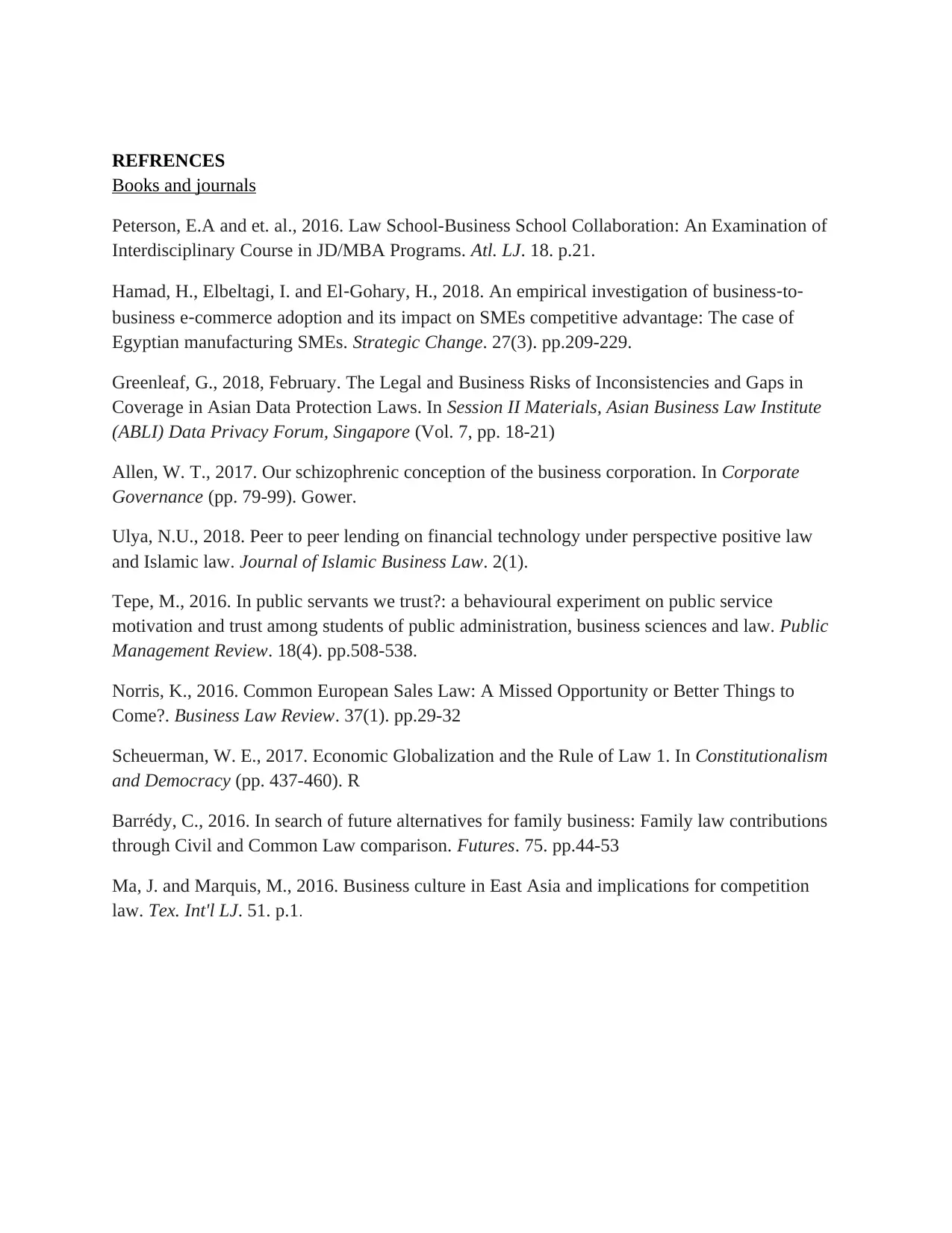
REFRENCES
Books and journals
Peterson, E.A and et. al., 2016. Law School-Business School Collaboration: An Examination of
Interdisciplinary Course in JD/MBA Programs. Atl. LJ. 18. p.21.
Hamad, H., Elbeltagi, I. and El‐Gohary, H., 2018. An empirical investigation of business‐to‐
business e‐commerce adoption and its impact on SMEs competitive advantage: The case of
Egyptian manufacturing SMEs. Strategic Change. 27(3). pp.209-229.
Greenleaf, G., 2018, February. The Legal and Business Risks of Inconsistencies and Gaps in
Coverage in Asian Data Protection Laws. In Session II Materials, Asian Business Law Institute
(ABLI) Data Privacy Forum, Singapore (Vol. 7, pp. 18-21)
Allen, W. T., 2017. Our schizophrenic conception of the business corporation. In Corporate
Governance (pp. 79-99). Gower.
Ulya, N.U., 2018. Peer to peer lending on financial technology under perspective positive law
and Islamic law. Journal of Islamic Business Law. 2(1).
Tepe, M., 2016. In public servants we trust?: a behavioural experiment on public service
motivation and trust among students of public administration, business sciences and law. Public
Management Review. 18(4). pp.508-538.
Norris, K., 2016. Common European Sales Law: A Missed Opportunity or Better Things to
Come?. Business Law Review. 37(1). pp.29-32
Scheuerman, W. E., 2017. Economic Globalization and the Rule of Law 1. In Constitutionalism
and Democracy (pp. 437-460). R
Barrédy, C., 2016. In search of future alternatives for family business: Family law contributions
through Civil and Common Law comparison. Futures. 75. pp.44-53
Ma, J. and Marquis, M., 2016. Business culture in East Asia and implications for competition
law. Tex. Int'l LJ. 51. p.1.
Books and journals
Peterson, E.A and et. al., 2016. Law School-Business School Collaboration: An Examination of
Interdisciplinary Course in JD/MBA Programs. Atl. LJ. 18. p.21.
Hamad, H., Elbeltagi, I. and El‐Gohary, H., 2018. An empirical investigation of business‐to‐
business e‐commerce adoption and its impact on SMEs competitive advantage: The case of
Egyptian manufacturing SMEs. Strategic Change. 27(3). pp.209-229.
Greenleaf, G., 2018, February. The Legal and Business Risks of Inconsistencies and Gaps in
Coverage in Asian Data Protection Laws. In Session II Materials, Asian Business Law Institute
(ABLI) Data Privacy Forum, Singapore (Vol. 7, pp. 18-21)
Allen, W. T., 2017. Our schizophrenic conception of the business corporation. In Corporate
Governance (pp. 79-99). Gower.
Ulya, N.U., 2018. Peer to peer lending on financial technology under perspective positive law
and Islamic law. Journal of Islamic Business Law. 2(1).
Tepe, M., 2016. In public servants we trust?: a behavioural experiment on public service
motivation and trust among students of public administration, business sciences and law. Public
Management Review. 18(4). pp.508-538.
Norris, K., 2016. Common European Sales Law: A Missed Opportunity or Better Things to
Come?. Business Law Review. 37(1). pp.29-32
Scheuerman, W. E., 2017. Economic Globalization and the Rule of Law 1. In Constitutionalism
and Democracy (pp. 437-460). R
Barrédy, C., 2016. In search of future alternatives for family business: Family law contributions
through Civil and Common Law comparison. Futures. 75. pp.44-53
Ma, J. and Marquis, M., 2016. Business culture in East Asia and implications for competition
law. Tex. Int'l LJ. 51. p.1.
1 out of 11
Related Documents
Your All-in-One AI-Powered Toolkit for Academic Success.
+13062052269
info@desklib.com
Available 24*7 on WhatsApp / Email
![[object Object]](/_next/static/media/star-bottom.7253800d.svg)
Unlock your academic potential
Copyright © 2020–2025 A2Z Services. All Rights Reserved. Developed and managed by ZUCOL.





